How to add gender pronouns in email signatures
See examples of pronouns in the email signature. See easy and accepted ways for adding your preferred pronouns in your email signature, introduction email & more.

Adding pronouns in your email can give people the confidence and clarity to address you like you would like to be addressed. Email signature gender pronouns in practice is simply another line in your signature that you can add besides your name, job title, and contact details.
You don’t need to add anything over-complicated or explanatory, just a simple addition of your pronouns will be enough for others to know how to address you in future email communications.
You can use these common formats:
- My pronouns are: She/her/hers
- My pronouns: she, her, hers and they, them, theirs
- Pronouns: he, him, his
- (they, them, theirs)
For example:
Sharron O’connor
Biology Teacher at Fuse School
Pronouns: she, her, hers
Phone: 858.534.2230
Email: sharron.oconnor@fuse.edu
Adding pronouns in email signature (examples)
With WiseStamp’s email signature generator, you can easily create a beautiful email signature that includes your email pronouns and all your professional and contact information, like your phone number, address, social links, and your picture.
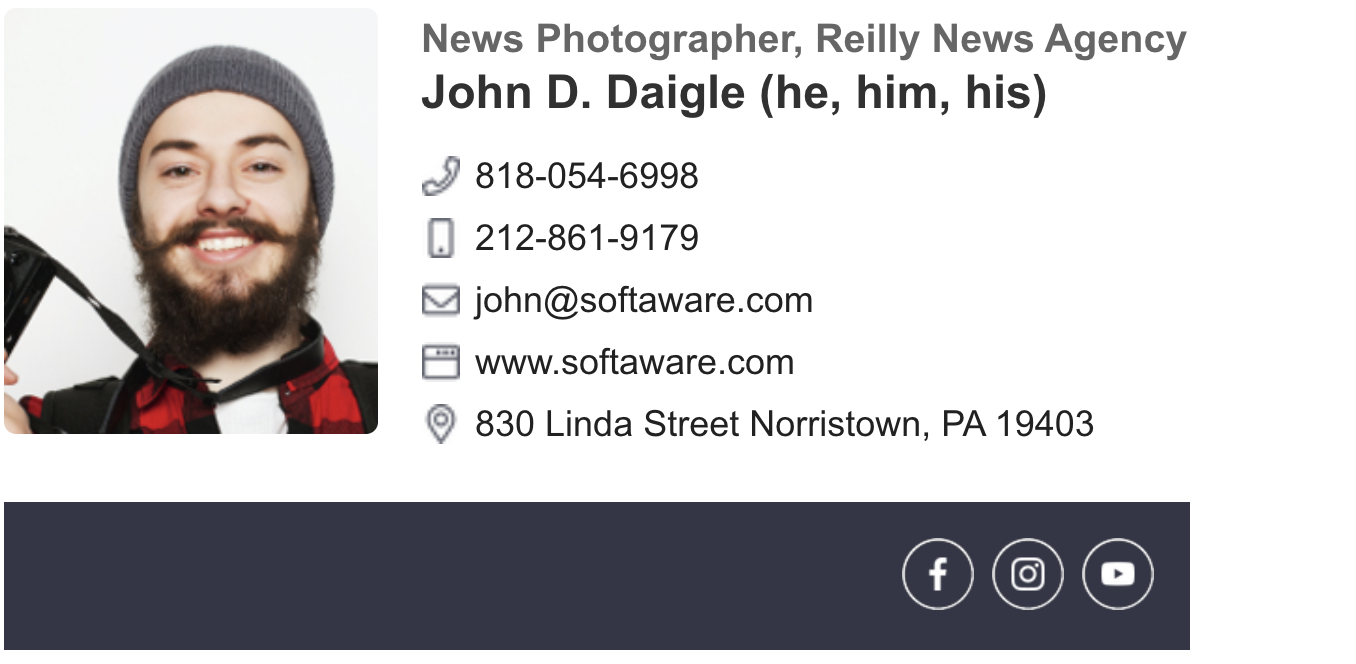
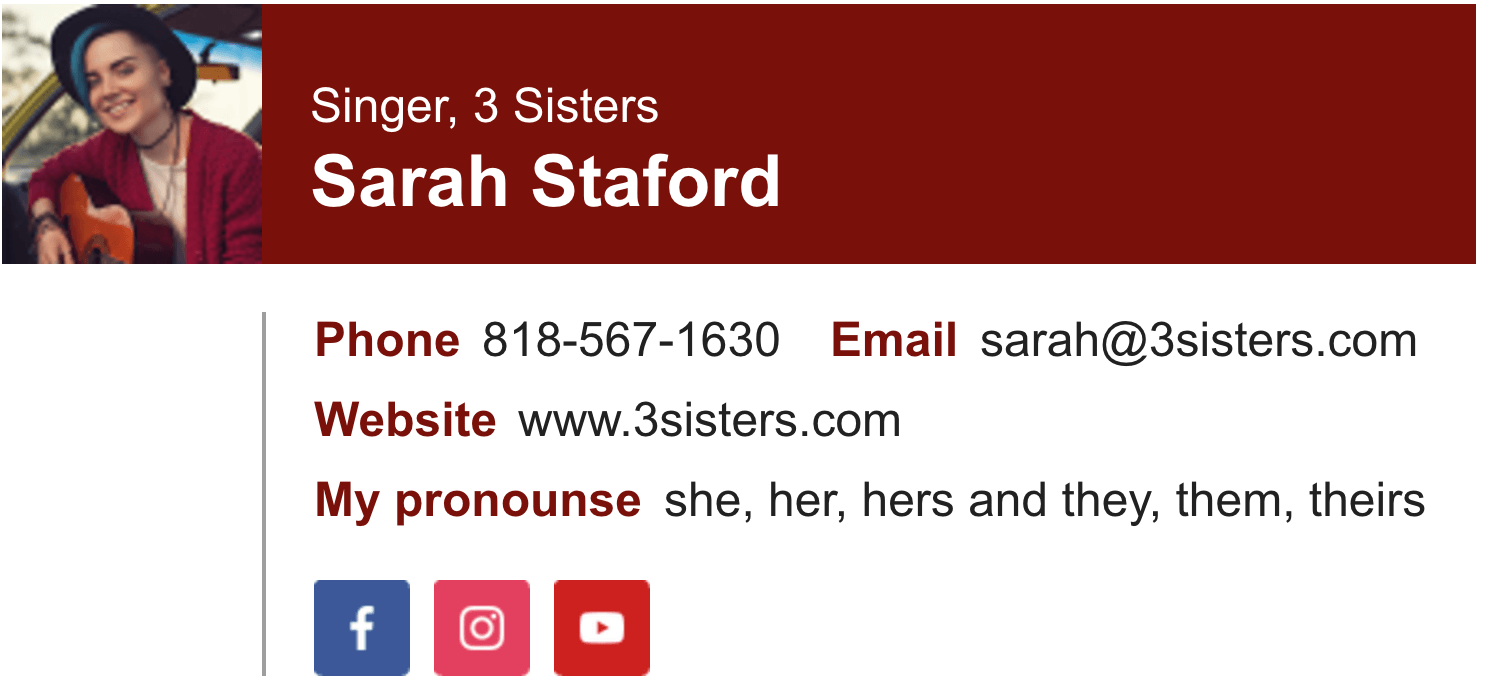
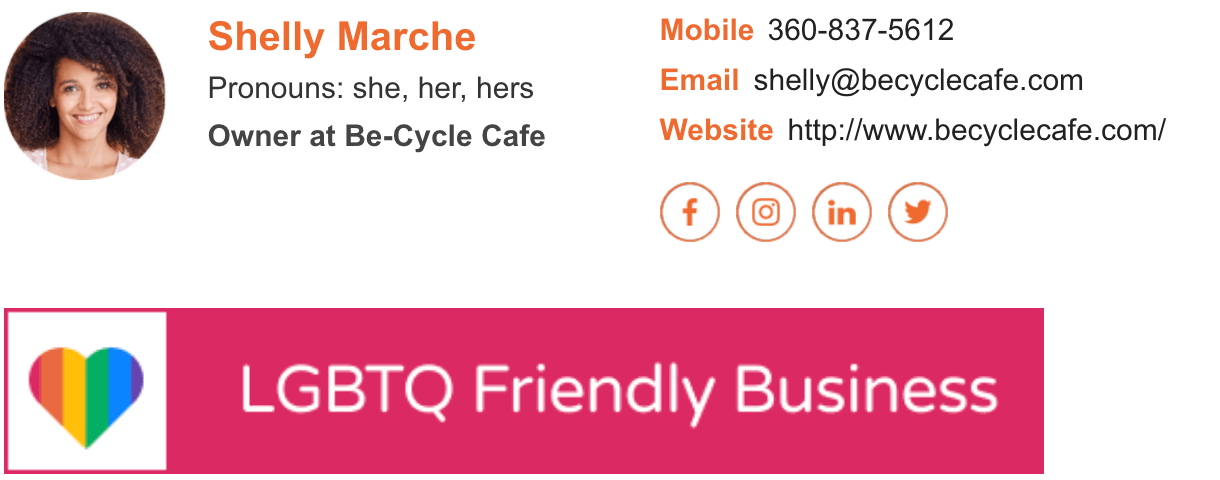

Should I include gender pronouns in my email signature?
The short answer is: yes. If you’re here asking this question, then you care about which pronouns people use to address you. If you care, then you should act. Let people know how they should address you. They may not even know it’s an issue, so it’s your responsibility to inform them, for the benefit of both sides.
Taking action in this way will lay down the road for empathic communication. It will remove your email recipients’ uncertainty about how to address you, and it will contribute to your emotional wellbeing. So the question is really, “why shouldn’t you include gender pronouns in my email signature?”.
The answer to “why not?” is that some people may see pronouns as a nuisance, and others may associate you with certain political views or liberal values. This may antagonize some people. But when all is said and done, you don’t have to take this into account; remember, your responsibility is toward your own wellbeing.
Adding pronouns to email signature
Follow the steps below to create a great looking email signature with pronouns in less than 5 minutes.
- Open the WIseStamp email signature generator
- Add your personal details and upload your image
- Click “Add more” to create a custom title
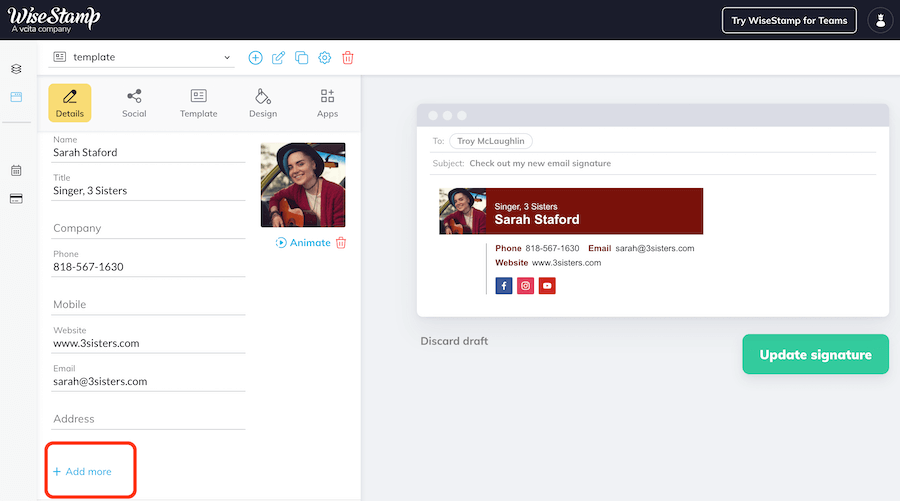
- Add “My pronouns” as your title
- Add your pronouns in the text field on the right > Click the green V to add your pronouns to your signature
- Click the green button titled “Update signature” (or “OK, I’m done” if this is the first signature you’re making with WiseStamp).
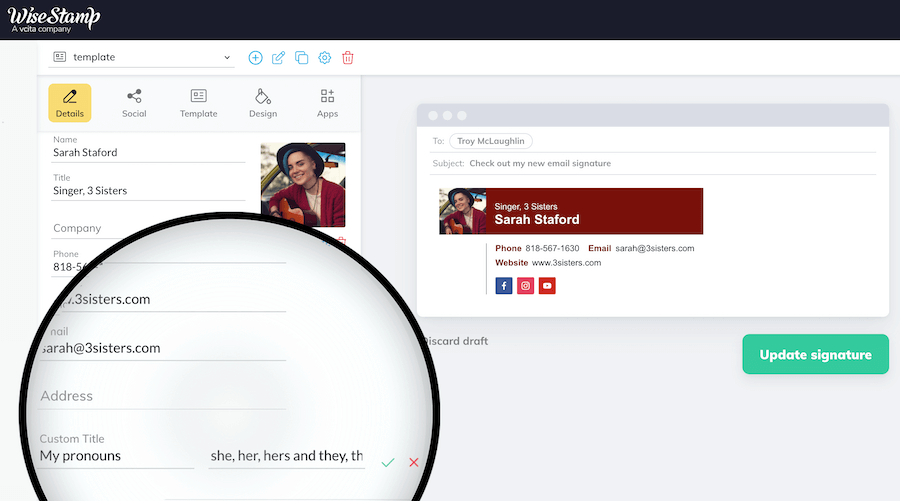

This pronouns email signature took me 2 minutes to set up
Why add pronouns to email signature?
Think of it this way: even if it doesn’t matter to you, it matters to someone. You never know the impact your words and action can have on others, and what business opportunities it can lead to.
Aside from their email signature, Max also added their pronouns to their LinkedIn profile next to their name and encouraged their clients to do the same. One of their clients added “he/him” to his LinkedIn profile, and shortly thereafter, a university reached out to him to inquire about internship placements at his company.
The university was looking for a placement for a transgendered student and though his company would be a good and safe fit.
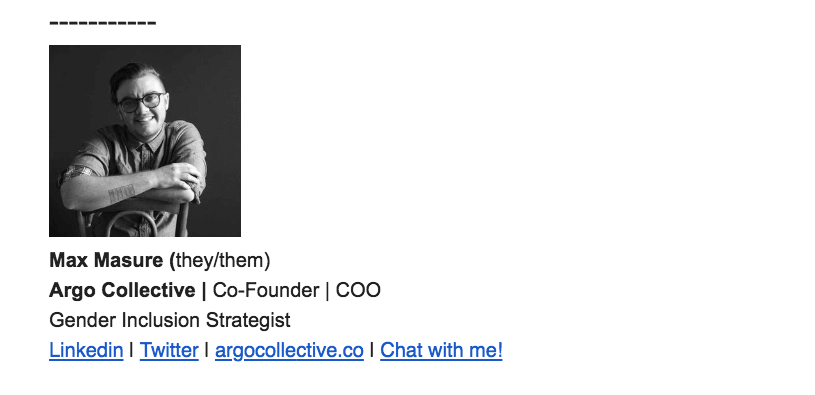
Max Masure’s email signature with a link to an article about adding pronouns to email signatures
Something as small as adding a few words to your email signature or LinkedIn profile can have a huge impact on your business. Both your clients and potential candidates will know that your business strives for inclusivity and is open-minded when it comes to learning new things about gender equality.
Again, even is misgendering or stating pronouns is not something you’re concerned about for yourself, it can be important to the recipient of your email. You won’t be seen as a “bad” or non-inclusive company if you don’t add pronouns in your emails.
However, adding them will simply give your business a small edge. Not only does it cost you no money and take almost no effort, but your brand will be seen by others as more inclusive, diverse, and approachable.
What are my gender pronouns?
As for your own gender pronouns, well, that depends on you! If you identify as cisgendered and use the pronouns for your sex assigned at birth, then you’re pretty lucky to not have to feel the burden of explaining your pronouns to others with every encounter.
It’s important to remember that not everyone feels this way, though, so the small act of asking someone their gender pronouns can go a long way in helping them feel more included.
3 most common email signature pronouns
There are actually dozens of different sets of gender pronouns someone might use. Still, the three traditional ones remain the most common:
- He/him/his: used for someone who says they identify as male or masculine.
- She/her/hers: used for someone who says they identify as female or feminine.
- They/them/theirs: used for someone who doesn’t particularly identify with neither female nor male pronouns. These pronouns are generally regarded as gender-neutral and are used in the singular form.
Aside from these three common sets of pronouns, there’s a whole slew of other ones that people who fall anywhere on the spectrum of gender might choose to use for themselves.
Email signature gender pronouns chart
| ___ laughed. | Ask ______! | That’s ____ pen. | That pen’s ____. | Did ___ enjoy ___? |
|---|---|---|---|---|
| he | him | his | his | himself |
| she | her | her | hers | herself |
| they | them | their | theirs | themself |
You don’t need to worry about learning all of these as you’ll likely only need to use them if you identify with any specific pronoun in the list.
How to introduce yourself using gender pronouns?

Introducing yourself with your pronouns doesn’t have to be very complicated. In a business setting, when you sit down for a meeting with someone new or if you’re at a conference, then you’d likely already find yourself introducing yourself by name and maybe even your position in your company. Adding your pronouns is just one extra step when you introduce yourself.
If you don’t want to vocalize your pronouns, some businesses have found interactive ways to communicate them using name tags or buttons. Under your name on a “Hello, my name is” sticker, you can add your pronouns and encourage others in your business to do the same.
What if someone doesn’t have their pronouns visible and they don’t mention anything? Most of the time, people won’t mention their pronouns, though it is becoming more common. The best rule of thumb is simply to use the person’s name where possible.
If you need to use a pronoun, don’t worry too much about misgendering them. It’s ok to make a mistake and the person will probably correct you. If you’re new to this whole concept, then you might make some slip-ups even after being corrected. It’s not the end of the world, but you should apologize and make an effort to use the right pronouns in the future.
Gender pronouns in email signature etiquette in business and at work
When you’re dealing with another person in a business setting, it’s important to take care that you are addressing them properly.
The last thing you’d want to do is unintentionally offend potential clients or business partners. It’s easier to ask someone in person about their pronouns, but it’s also possible to do this respectfully over email calls for email etiquette.
If you’ve never heard someone state “my pronouns are…” then you might find yourself a little confused at the distinction when it’s made online.
Nowadays, it’s generally accepted that some people may not identify with the pronouns they were given at birth and prefer to be identified in a different way. Let’s look at the different gender pronouns you can use in your email signature.
What does it mean when someone says “my pronouns are?”
There are countless different reasons why someone may not identify with the gender they were born with. At the end of the day, though, the specific reasons or feelings being someone else’s gender aren’t really of your concern as a business owner or representative of a business.
Of course, if the person you’re speaking to is a friend or a close work colleague and they are open to discussing it, you can ask to learn more about their personal reasons or experience. Still, using someone’s gender pronouns shouldn’t be something that is contingent on having “the full picture.” It’s a sign of respect, understanding, and inclusivity, and can also greatly impact how your business is perceived by others.
When someone tells you “my pronouns are…” then they are signaling that this is the gender they want to be addressed as moving forward in all forms of communication. The gender they tell you might not be the same as their appearance if they look typically female or male, but it’s important that you listen to what each person tells you as opposed to your assumptions based on physical traits like how they dress or style their hair.
Gender pronouns aren’t only for transgendered or non-binary people, but they can be applied to cisgendered people as well. Essentially, stating your gender pronouns in emails or in professional settings simply normalizes the conversations surrounding gender and identity.
Glossary of terms
It’s important to have a well-rounded understanding of the language that surrounds this topic. Here are a few terms and their definitions you might find helpful in understanding this discussion:
- Cisgender: an individual who identifies with and gender that corresponds to the sex they were born with.
- Non-binary: an individual who doesn’t identify as male or female to categorize their gender. If you’re still unsure about this term or how to relate to it, try and research and learn more about gender non-binary individuals and their experiences.
- Transgender: An individual who expresses their gender and identifies themselves as something other than the sex they were born with.
- Preferred pronouns: the pronouns that an individual would like to be addressed as. However, recently, there some debate about using the term “preferred pronouns” since it implies that these pronouns are a preference instead of something that must be used.
Should I include pronouns in my company email signature?
It’s one thing to add your pronouns to your own signature, but if you’re a part of a company, it could be more difficult to convince all the employees to follow suit. If you’re looking for ways to convince your coworkers to also add their pronouns to their emails, there are a few strategies you can use:
- First, speak with your HR representative and explain why you believe it’s important to add pronouns to your business emails.
- If you are in a management position, let your team know that it’s ok if they want to start adding their pronouns to their email signatures.
- Try not to make this a forced change, as then you might be more likely to receive pushback. Instead, let your staff know that it’s a suggestion, but it’s not mandatory. As more and more employees begin to add their own pronouns in professional email signatures, it’s possible that others will jump on board as well.
- Have conversations with coworkers about why getting someone’s pronouns correct is important to your business, and how misgendering someone can actually negatively impact your business or the perception of your brand.
Bottom Line
Chances are you’ll encounter someone through your business who is gender non-binary. Even if you don’t encounter them through your work, you can still meet them in social settings, and the same pronoun rules would apply. In fact, 1 out of 5 Americans personally know someone who goes by specific gender pronouns.
If you think about it, you probably email dozens of people each day. Some of them may be coworkers you’re familiar with and you know how to address them. Some of them may also be clients you’re already comfortable with. And some of them may be new business associates, clients, or even new employees and you will have to be comfortable learning their gender pronouns.


